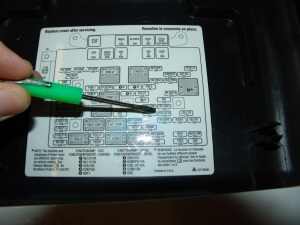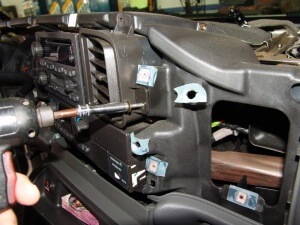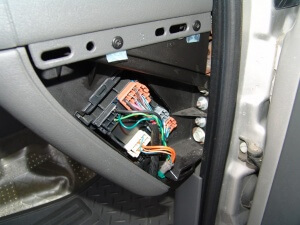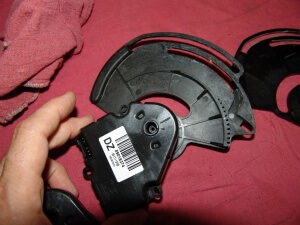
This 2003 Chevrolet Silverado came in with the air flow stuck on defrost. A simple diagnosis of a code B0263 found a faulty mode actuator. This repair applies to 2003, 2004, 2005, 2006, 2007, 2008, 2009, 2010, and 2011 Chevrolet Avalanche, Silverado, Suburban and Tahoe. It also applies to Cadillac Escalade, GMC Sierra and Yukon for the same year models.
It is specific to all models WITH auto a/c controls.
Models with manual a/c controls, WITHOUT a factory floor mounted center console.Trucks that have manual a/c controls and WITH a factory floor mounted center console, use a slightly different actuator and procedure. On that model the gear/cog seperates from the actuator. Before removing that actuator use something to hold the gear/cog in place while the actuator is being removed. If it comes off, it will take some time to figure out where the gear/cog and the three levers go. I hope to do a post on that model soon.In the meantime, if you need to order this part for a full sized truck or suv, that has manual a/c controls and a factory floor mounted center console (RPO Code D07), that is not shown in this post, please click here.
Now onto this repair.The actuator is located under the driver's side of the dash, above the gas pedal area, and on the end of the heater a/c case.
I know this will seem quite simplistic but the very first thing I do during this repair is, to push down the parking brake pedal. I cannot turn under the dash with it up.
Then either by hand or using the tool shown in the pictures, I pull the retaining pin out that holds the heater duct in place.
A better view of the retaining pin.
This is the view of the heater vent with the extension removed. The actuator is above the duct. Inn case you are wondering the piece in the duct is the duct temperature sensor.
A better view. I had to place the camera behind the brake pedal so the angle is slightly different from what you will see. There are two 5.5 mm headed screws that hold the actuator in place. The upper screw also holds the wiring harness retaining clip as well. I have pictures of that later. Try to set the old actuator to the same position as the new one before removing. To do this switch the ignition on and have someone depress the defroster button for you. While looking at the slot on the center shaft also have one hand on the ignition switch. Turn the ignition off just before the slot lines up with the appropriate hash mark. If this is not possible for you just set the controls to the split defrost and floor position. This will make it easier to slip the actuator out. Lift the edge of the actuator, that is closest to the firewall, away from the heater a/c case. It can take a good bit aof patience and manipulation to remove the old actuator. So take your time and don't caveman it out.
This enables the large cog to come out from under the pin on the white lever gear. Remember which slot it was in, the inner one.
Now that the actuator is out of the way, you can see the two door levers. The small black one to the left is for the defroster door. The larger white one with the gear teeth attached is for the vent / floor door.
The old actuator on the left and the new one on the right.
Note the position of the actuator cog to the actuator motor. The actuators come prepositioned to allow for easier assembly. Do not connect the wiring to the actuator until the new actuator is installed. If you do for some reason, refer back to this picture to reindex the actuator to the correct position.
To purchase a new actuator please click here.
Slide the new actuator into place in the reverse order that you pulled it out. Once it is generally back in place make sure that the peg on the back side of the white gear lever is in the inner slot of the actuator cog. Then while holding it gently in place reach up to the top side of the cog and make sure that the defroster lever is in its slot under the cog. Now take your time and gently maneuver the actuator around until the actuator drops completely into place. The two door lever pins have to be lined up. The actuator has to be lined up with the two mounting bosses, the center rings on the actuator cog and the heater a/c case also have to be lined up. Remember patience and gentle maneuvering and it will drop that last little 1/4" to 3/8" to the mounting bosses. Do not force or use the screws to draw it down. You will likely break something or have a jammed actuator at the very least.
Remember when installing the mounting screws that the upper screw hold down the wiring harness retainer clip.
I used a 1/4" palm ratchet and 5.5 mm deep well socket to remove and install the screws.
The new actuator installed.
This truck has auto a/c controls. The part and the basic repair are the same whether it has manual or auto controls. I have not done one on the newer body style truck but I would assume at this point it will be similar. This repair of course should be generally the same for 2003 through 2007 Classic series trucks and suvs.
Remember to preset the controls to the split defrost / floor position before removing the old actuator. If needed, use a small screwdriver or the edge of a quarter to rotate the actuator into the correct position. Once in place disconnect the wiring at the actuator. If you are manually assisting the actuator, you must do it withing the first minute or two of switching the ignition on. The system will try to adjust to the commanded position for a minute and then stops trying. At that point the motor will not be able to be assisted. The ignition will need to be turned off for at least ten seconds and then back on for another attempt.
To perform a recalibration of the newly installed actuator, I used a Tech 2 scan tool. If you do not have a scan tool you have two choices. Remove the fuse shown below for one minute or disconnect the battery for one minute. After the fuse is installed or the battery is reconnected, start the engine and let it run for at least one minute (I prefer the old time of 4 minutes). DO NOT TOUCH the a/c controls during this time. Turn the ignition off for at least ten seconds. Restart the engine and check the a/c operation.
The fuse location and name may be different for other vehicles. This of course is a 2003 Silverado.
Please look closely at the picture below so that you can identify where the two door levers are. I have had some people tell me that there is only one. The defroster lever has a pin sticking up that has to be aligned in a closed slot in the under side of the actuator cog. The white vent/floor gear lever has a pin on the underside that must drop into the inner open slot in the actuator cog. The gear teeth should self align when the actuator is moved.
I am building a test procedure for this actuator. Current testing is as follows.
At the mode actuator, with the ignition switched on, check for battery voltage on the brown wire.
Check for a 5 volt reference signal on the light blue/black wire.
The yellow wire should show ground as it is the reference low signal from the control head assembly.
The light green wire should have a variable 0-5 volt signal on it. This is the actuator position signal.
The tan wire is the command signal wire. There should be one of three voltages present as different modes are commanded.
5 volt signal is the command for counter clockwise rotation.
2.5 volt signal is the stop command.
0 volt command is for clockwise rotation.
I have found through bench testing an actuator that there is a nominal 2.5 volt output from the actuator on the tan wire. The control head therefore must apply a ground on the tan wire to reduce the voltage to zero to command clockwise rotation. It must also apply voltage to bring the reading to 5 volts in order to command counter clockwise rotation.
All voltages referred to above should be considered nominal volts. In testing, I found that a variation of .75 volts from the 2.5 volt stop command was enough to move the actuator.
When doing testing, if you find no variation on the tan wire, do not jump to the conclusion that the control head is faulty. The system will go into a "sleep mode" if a hard fault is found with an actuator. The system will determine this within a minute or two of turning the ignition on. You have to have your meter set up and ready to see the reading before you actually turn the key on. You may also have to clear hard fault codes before the system will even try to move the affected actuator. You can clear the codes with a scan tool, remove the HVAC memory fuse or disconnect the battery.
If any of the signals are missing, check the wiring at the right and left junction boxes at either end of the dash. Look for signs of corrosion, general looseness or fretting. Locations can vary from year to year and model to model. Please consult a wiring diagram.
The post 2003 Chevrolet Silverado, Changing the Mode Actuator, Code B0263 appeared first on Sparky's Answers.














































































































































